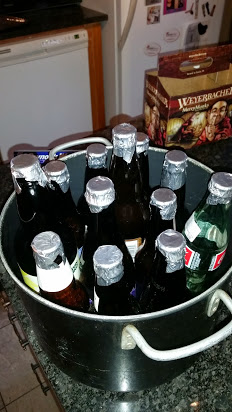BamaPhil
Well-Known Member
I've just had to dump another batch. I could just cry.
I dumped a batch and a half a couple months ago. My theory was that I let my StarSan go too long (I was quickly blasted in the sanitation forum for having such a theory and sent home in shame) and it lost its effectiveness.
I bought pH strips to ensure my sanitizer was effective. I bleach bombed everything. I doubled my cleaning and sanitation efforts before, during, and after each brew. My next brew turned out fantastic- a cherry wheat that has avoided the infection and has been deemed "commercial quality" by several folks. I was ecstatic that I had finally hit my stride as a brewer.
Now my second attempt at an MO/EKG SMASH has gotten infected in the bottles. I even had my first bottle bomb. If I had to guess I would say it's acetobacter just based on what I've read. It has kind of a burn on the back of the throat and is what I guess is "astringent," although I'm not really sure I know what that really means.
Nothing changed between the cherry wheat and the SMASH. I cleaned harder, oxicleaned everything. Nothing touched it post-boil without at least a 30 second contact time with StarSan (which is exactly what I'd always done, but now I count how long I dunk my thermometer when chilling). I started sanitizing my IC, not trusting the boil alone. No stone unturned.
All I can do is replace everything on the cold side that's not glass. Man I hope my hefe that's in primary is ok.
What's so frustrating is I know I'm more careful than many that don't have this trouble. I read so much and hear so many on podcasts talk about "just soak it in oxiclean and rinse," "clean after use, sanitize before," "RDWHAHB."
I'm depressed.
I dumped a batch and a half a couple months ago. My theory was that I let my StarSan go too long (I was quickly blasted in the sanitation forum for having such a theory and sent home in shame) and it lost its effectiveness.
I bought pH strips to ensure my sanitizer was effective. I bleach bombed everything. I doubled my cleaning and sanitation efforts before, during, and after each brew. My next brew turned out fantastic- a cherry wheat that has avoided the infection and has been deemed "commercial quality" by several folks. I was ecstatic that I had finally hit my stride as a brewer.
Now my second attempt at an MO/EKG SMASH has gotten infected in the bottles. I even had my first bottle bomb. If I had to guess I would say it's acetobacter just based on what I've read. It has kind of a burn on the back of the throat and is what I guess is "astringent," although I'm not really sure I know what that really means.
Nothing changed between the cherry wheat and the SMASH. I cleaned harder, oxicleaned everything. Nothing touched it post-boil without at least a 30 second contact time with StarSan (which is exactly what I'd always done, but now I count how long I dunk my thermometer when chilling). I started sanitizing my IC, not trusting the boil alone. No stone unturned.
All I can do is replace everything on the cold side that's not glass. Man I hope my hefe that's in primary is ok.
What's so frustrating is I know I'm more careful than many that don't have this trouble. I read so much and hear so many on podcasts talk about "just soak it in oxiclean and rinse," "clean after use, sanitize before," "RDWHAHB."
I'm depressed.




